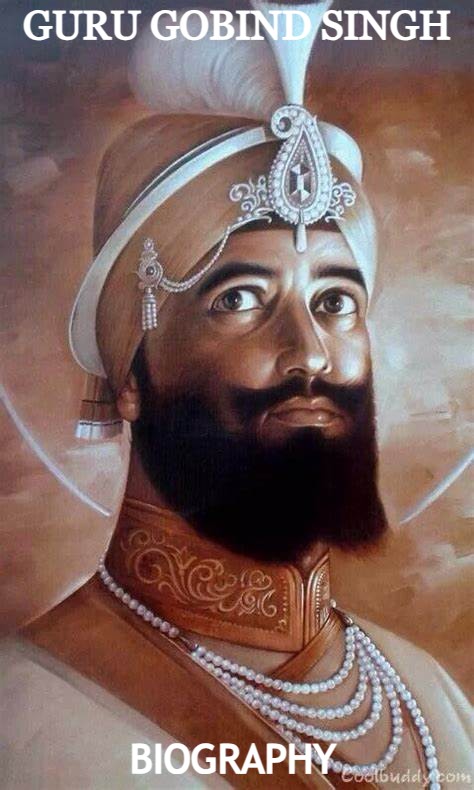Introduction
Guru Gobind Singh, born in 1666, was the tenth Guru of the Sikhs. He founded the Khalsa, a group emphasizing bravery and equality. He lost family members in the face of battles but showed resilience. He wrote important texts and completed the Guru Granth Sahib. Sensing his end, he handed over leadership to the Guru Granth Sahib and died in 1728, leaving a powerful impact on Sikh history.
Table of Contents
Guru Gobind Singh : Birth and Early Life

Guru Gobind Singh was born on 20 December 1666 in Patna to Guru Tegh Bahadur and Gujri. Originally named Govind Rai, he received his early education in Persian, Sanskrit and martial arts while traveling with his family.
Father’s Sacrifice

Guru Tegh Bahadur played a key role in protecting Kashmiri Hindus from forced conversions by the Mughals. Before Guru Tegh Bahadur set out on his journey to Delhi, he made the momentous decision of appointing Govind Rai as his successor.
Formation of Khalsa

After the execution of Guru Tegh Bahadur by the Mughal authorities, Govind Rai officially assumed the role of the 10th Guru on Baisakhi in 1675. Later, in 1699, he inaugurated the Khalsa, a momentous event that included the Amrit ceremony and the adoption of the five symbols, marking a transformative phase in Sikh history.
Khalsa Battles
Guru Gobind Singh actively participated in numerous battles against the Mughal armies and faced significant conflicts at places like Bhag Gani, Badaun, Guler, Nirmoh Garh, Recovery, Anandpur and Muktsar. These commitments underscored his determination to defend the Sikh community and resist oppression, contributing to a chapter of resilience and courage in Sikh history.
Tragic Loss
Tragedy struck Guru Gobind Singh as he faced the loss of his two elder sons in battles, highlighting the profound sacrifices his family had made in pursuit of justice and freedom. Younger sons, captured by Mughal forces, were additionally executed. This series of heartbreaking events tested the Guru’s resilience and commitment to the Sikh cause and epitomized the immense sacrifices that had been made in the fight against oppression.
Aurangzeb’s Rule
Guru Gobind Singh persevered in his opposition to the Mughals and kept up the fight until the death of Aurangzeb in 1707. The ascension of Bahadur Shah as the new emperor marked a change in dynamics, with the new ruler paying homage to Guru Gobind Singh. Despite the challenging circumstances, this shift in leadership offered a different perspective on the relationship between the Sikh community and the ruling powers of the time.
Hostility from Sirhind

Nawab Wazir Khan of Sirhind, alarmed by Guru Gobind Singh’s friendly relations with the Gurus, hatched a sinister plot to assassinate him. The Nawab’s enmity arose out of the Guru’s harmonious relationship with the spiritual leaders, which posed a perceived threat to his own authority. Brewer hostilities culminated in a dangerous plot to eliminate Guru Gobind Singh, underscoring the challenges and threats facing the Sikh leader during this period.
Major Works
Guru Gobind Singh made a significant contribution to Sikhism by establishing the Khalsa, a collective body responsible for both the executive and military civil authorities in Sikh society. Apart from shaping the administrative structure, he played a key role in completing the composition of the Guru Granth Sahib, the revered and sacred text of the Sikhs. Through these actions, Guru Gobind Singh solidified the spiritual and organizational foundations of Sikhism and left a lasting impact on the faith and its followers.
Personal Life

Guru Gobind Singh’s personal life included three marriages as reported by various sources listing Mataji, Mata Sundari and Sahib Devi as his wives. This polygamous aspect of his life is subject to historical interpretation. From these unions, Guru Gobind Singh was blessed with four sons: Ajit Singh, Jujhar Singh, Zorawar Singh and Fateh Singh. This family dynamic played a key role in shaping Guru Gobind Singh’s legacy and contributed to enduring stories in Sikh history.
Death
In 1760, Guru Gobind Singh, sensing the approaching end of his life, made a poignant decision to hand over the mantle of leadership to Guru Granth Sahib. This symbolic gesture marked a profound moment in Sikh history and emphasized spiritual continuity within the community. Subsequently, Guru Gobind Singh died in Nanded in October 1728, leaving behind a legacy of sacrifice, resilience and spiritual leadership that continues to resonate with Sikhs worldwide.
